
| HOME | SEARCH | ABOUT US | CONTACT US | HELP | ||
| |
| This is an obsolete version of the rule. Please click on the rule number to view the current version. |
|
24.1.101 ORGANIZATION OF DEPARTMENT OF LABOR AND INDUSTRY (1) History and Purpose. The Department of Labor and Industry was implemented under the Executive Reorganization Act of 1971 by executive order of the Governor on December 13, 1971. The Department of Labor and Industry provides oversight and regulation of the Montana Workers' Compensation system, enforces state and federal labor standards, enforces state and federal safety and occupational health laws, provides adjudicative services in labor-management disputes, establishes and enforces building industry codes, licenses and regulates professions and occupations, regulates all weighing or measuring devices used in commercial transactions, conducts research, and collects employment statistics that enable strategic planning. The department operates as part of a national employment, unemployment insurance, and job training system that assists individuals in preparing for and finding work, and helps workers obtain benefits if they are temporarily unemployed through no fault of their own. The department receives and investigates complaints of discrimination in the areas of employment, housing, public accommodations, education, financial and credit transactions, insurance, and government services. Technical assistance and education are provided to employers, housing providers, and individuals to clarify state and federal discrimination law. (2) Organization. The Department of Labor and Industry is headed by the commissioner, appointed by the Governor as prescribed by Article XIII, section 2 of the Montana Constitution. The department is made up of five divisions. Each division is headed by an administrator, and is divided into bureaus headed by a chief. There are various entities attached to the department for administrative purposes as provided in 2-15-121, MCA. (3) Structure. The department structure is as follows: (a) Commissioner's Office. The commissioner is responsible for the administration of the department and its divisions. (i) In addition to the divisions, the commissioner has certain staff that report directly to the commissioner and are independent of the divisions: (A) Office of Human Resources. The Office of Human Resources provides general personnel recruiting, selection, and other human resource functions for the department. (B) Office of Legal Services. The Office of Legal Services provides legal advice and representation to the commissioner, the divisions, and the administratively-attached entities. (C) State Workforce Investment Board (SWIB). The State Workforce Investment Board is responsible for advising the Governor on the creation, implementation, and continuous improvement of a comprehensive statewide workforce development system, designed to train the maximum number of unemployed and underemployed Montanans as possible. (ii) Several entities are attached to the commissioner's office for administrative purposes only. These entities are: (A) Office of Community Service. The Office of Community Service, a part of the Governor's Office, is attached to the department for administrative purposes only. The Office of Community Service is located at 1301 Lockey Street, Suite 304, Helena, and coordinates volunteer service projects throughout the state of Montana, including but not limited to the Montana Conservation Corps and the Montana affiliate of the AmeriCorps program. (B) Workers' Compensation Court. The Workers' Compensation Court created by 2-15-1707, MCA, is attached to the department for administrative purposes only. The Workers' Compensation Court is located at 1625 11th Avenue, Helena. The workers' compensation judge is appointed by the Governor for a six-year term. The workers' compensation judge must meet all the requirements of Montana district court judges and, upon appointment, is granted all of the rights, privileges, and emoluments of office afforded Montana district court judges. The workers' compensation judge adjudicates workers' compensation and occupational disease cases. The Workers' Compensation Court adopts rules separately. (b) Divisions. The department consists of the following divisions: (i) Business Standards Division; (ii) Centralized Services Division; (iii) Employment Relations Division; (iv) Unemployment Insurance Division; and (v) Workforce Services Division. (c) Administratively attached entities. The administratively attached entities include the Board of Labor Appeals, Commission for Human Rights, Board of Personal Appeals, and various professional and occupational licensing boards. These entities and their functions are listed within the division descriptions. Each of these entities adopt rules separately. (4) Functions. The functions of the divisions, bureaus, boards, and commission of the Department of Labor and Industry are as follows: (a) Business Standards Division: establishes and enforces minimum building, plumbing, mechanical, electrical, energy, elevator, and boiler codes as well as licenses, inspects, tests, and certifies all weighing or measuring devices used in commercial transactions. The division is also charged with licensing and regulating persons and businesses engaged in specific professions and occupations. Administratively attached to the Business Standards Division are 32 separate professional and occupational licensing boards. (i) Building Codes Bureau is responsible for establishing and enforcing building standards and licensing certain related occupations. The Building Codes Bureau establishes and enforces minimum building (including accessibility), plumbing, mechanical, electrical, energy, elevator, and boiler standards to safeguard the public in the design and construction of buildings. In addition, the program directly regulates and licenses construction blasters, boiler operating engineers, cranes and hoisting operating engineers, issues elevator operating certificates, regulates entities who engage in the business of selling, servicing, or installing fire prevention systems, and issues fireworks wholesaler permits. (ii) Business and Occupational Licensing Bureau provides administrative support to 11 governor-appointed boards regulating nonhealth care professions and occupations and to the athletics program without a regulatory board. The following regulatory boards are attached to the Business and Occupational Licensing Bureau for administrative purposes only: (A) Board of Architects and Landscape Architects. Implements laws concerning the practice of architecture and landscape architecture in the state to protect the public from unprofessional, improper, unauthorized, or unqualified practice of architecture and requiring that only properly qualified persons are licensed to practice landscape architecture in the state. (B) Board of Barbers and Cosmetologists. Protects the health, safety, and welfare of the public by inspecting shops, salons, and schools in the state and assures the public that licensees meet standards of competency in their practice. Monitors training in cosmetology, manicuring, electrology, and esthetician schools to assure expertise of licensees in the professions. Through regulations, licensing, and inspections, it ensures the compliance of all licensees under its jurisdiction with statutes and rules, with particular emphasis on rules regulating sanitation. (C) Board of Outfitters. Protects the consumers of outfitter and guide services by requiring that only properly qualified persons are licensed to practice outfitting and guiding in Montana. (D) Board of Plumbers. Protects the public from unsuitable plumbing practices by investigation of complaints and adequate examination of applicants to determine their competence, experience, and other qualifications. (E) Board of Private Security. Provides for licensure and regulation of persons who engage in investigation and private or proprietary security patrol with special regulation and training of armed persons engaged in such activities. Since people licensed in this field have access to homes, business concerns, and information, the law requires that the licensed individuals meet specific requirements and standards to properly protect the consumer of these services. The board also provides for the licensure of fire investigators. (F) Board of Professional Engineers and Professional Land Surveyors. Safeguards life, health, and property, and promotes public welfare by ensuring that only qualified applicants become licensed and regulates the practice of those licensed. (G) Board of Public Accountants. Administers the Uniform Certified Public Accountants Examination and processes licensing for all qualified applicants who pass the examination and meet all other requirements, licenses those qualified individuals from other states who apply for Montana licensure, administers a positive enforcement program for existing licensees, and regulates its own profession by investigating complaints submitted. (H) Board of Real Estate Appraisers. Regulates the licenses of real estate appraisers and safeguards the public interest by requiring the maintenance of high standards and ethical practices by all real estate appraisers. The board investigates complaints from the general public and from the industry itself regarding the conduct of licensees. (I) Board of Realty Regulation. Regulates the licenses of real estate brokers, salespersons, property managers, and timeshare sales offerings. This safeguards the public interest by requiring the maintenance of high standards and ethical practices by all real estate licensees. The board investigates complaints from the general public and from the industry itself regarding the conduct of real estate transactions. (J) Board of Sanitarians. Regulates persons working in the field to ensure that they are qualified through education and practical experience. (K) State Electrical Board. Protects the health and safety of all Montanans by regulating by whom electrical installations are made, insuring their competence, and determining that electrical installations and products made and sold in the state meet minimum safety standards. (iii) Health Care Licensing Bureau provides administrative support to 21 governor-appointed boards licensing health care professions and occupations. In addition, the bureau directly regulates and licenses addiction counselors without a regulatory board. The following regulatory boards are attached to the Health Care Licensing Bureau for administrative purposes only: (A) Alternative Health Care Board. Regulates naturopathic physicians and direct-entry midwives by reviewing applications, conducting examinations, and monitoring the practice of licensees. The board also regulates and licenses midwife apprentices. (B) Board of Athletic Trainers. Regulates the practice of athletic training. (C) Board of Chiropractors. Regulates chiropractic activities in Montana by examining and licensing only those who meet statutory qualifications. The board also monitors the practice of all licensees to assure the public of professional competence in the chiropractic field. (D) Board of Clinical Laboratory Science Practitioners. Regulates persons working in the field to ensure that they are qualified through education and practical experience. (E) Board of Dentistry. Regulates the profession of dentistry and dental hygiene in Montana by reviewing applications, conducting examinations, and monitoring the practice of licensees. The board also regulates and licenses the practitioners of the profession of denturitry. (F) Board of Funeral Service. Guarantees that those persons working in the field meet professional competency requirements. The board inspects and licenses funeral homes to ensure that they meet public health standards as set by state law and rules, which include disclosure statements to protect the public from unscrupulous practices. (G) Board of Hearing Aid Dispensers. Regulates and licenses those persons dispensing hearing aids to ensure that they are of good character and have the necessary training and experience. The selling and fitting of hearing aids affects the health, safety, and welfare of the consuming public. (H) Board of Medical Examiners. Ensures that the public is properly protected against unprofessional, improper, unauthorized, or unqualified practice of medicine. All credentials of physicians, nutritionists, osteopaths, acupuncturists, physician assistants, podiatrists, and emergency medical technicians are reviewed by the board to ensure that only those individuals who meet the requirements of the statutes are licensed to practice in Montana. (I) Board of Nursing. Licenses nurses and approves nursing schools. The board ensures that all licensees meet the necessary educational requirements and successfully complete the state board licensing examination. The standards for all nursing programs are set by the board, and approval of the school is determined by compliance with those standards. (J) Board of Nursing Home Administrators. Regulates and licenses nursing home administrators to ensure that they are individuals of good character trained and experienced in the field of institutional administration. (K) Board of Occupational Therapy Practice. Enforces the Occupational Therapy Practice Act by regulating and licensing the practitioners in order to assure and protect the public that persons representing themselves as occupational therapists are fully qualified. (L) Board of Optometry. Is responsible for protecting the visual health of the people of Montana by ensuring that all applicants for licensure are qualified and competent in the optometry field, optometrists in active practice maintain their competency, and that optometrists meet continuing education requirements. (M) Board of Pharmacy. Carries out legislative mandates and decisions pertaining to the practice of pharmacy, including licensing of practitioners and control of distribution and dispensing of drugs and medical devices. (N) Board of Physical Therapy Examiners. Protects the public health and safety by ensuring that all physical therapists and physical therapy assistants practicing in the state meet statutory requirements of training and competence. (O) Board of Private Alternative Adolescent Residential or Outdoor Programs. Licenses and regulates private alternative adolescent residential or outdoor programs as a public service to monitor, maintain, and ensure a high standard of care and to ensure the safety and well-being of the adolescents and parents using the programs. (P) Board of Psychologists. Licenses psychologists to ensure that those practicing maintain high standards in order to protect the public against persons who would cause irreparable mental harm to consumers. (Q) Board of Radiologic Technologists. Protects the public from the unprofessional, improper, unauthorized, or unqualified practice of radiologic technology. (R) Board of Respiratory Care Practitioners. Protects the public from the unprofessional, improper, unauthorized, or unqualified practice of respiratory care. (S) Board of Social Work Examiners and Professional Counselors. Sets standards of qualification, education, training, and experience and establishes professional ethics for the practice of social work and professional counseling. (T) Board of Speech-Language Pathologists and Audiologists. Regulates persons offering speech-language pathology or audiology services in order to ensure the highest possible quality speech-language pathology and audiology services to the people of the state. The board works with the special education department of the Office of Public Instruction in resolving problems that may arise concerning applicants for licensure. (U) Board of Veterinary Medicine. Ensures the public that those persons practicing veterinary medicine in Montana meet and maintain educational and professional standards of competence. (iv) Weights and Measures Bureau tests, inspects, and calibrates all commercial weighing and measuring devices used in commercial transactions in the state. The program also investigates complaints regarding the accuracy of commercial weighing and measuring devices. (b) Centralized Services Division: The Centralized Services Division provides supportive services to the Department of Labor and Industry including budget, accounting, payroll, and information services functions, and provides administrative hearing officers to the department and various boards. (i) Fiscal Support Bureau provides services to the department in the areas of budget and financial management, accounting, fiscal reporting, payroll and benefits, cash receipting and distributing, internal controls, procurements including contracts for services and the purchasing of supplies and equipment. (ii) Hearings Bureau holds impartial administrative hearings and provides dispute resolution services in unemployment insurance cases, wage and hour claims, public employee collective bargaining and unfair labor practices cases, state employee classification appeals and grievances, uninsured employer regulatory matters, professional and occupational licensing appeals, and human rights complaints. It provides a fair, speedy, inexpensive, and simple hearings process for resolving disputes. (iii) Technical Services Bureau maintains the integrity and availability of computerized information systems for the department and some of its functions. (c) Employment Relations Division: The Employment Relations Division upholds public policy as it relates to employment relationships and illegal discrimination. The division has general regulatory duties concerning the Workers' Compensation and Occupational Disease Acts. It also administers the wage and hour laws and certain occupational safety laws. The division also is the administrative agency of the Board of Personnel Appeals and the Commission for Human Rights. (i) Board of Personnel Appeals created by 2-15-1705, MCA, is attached to the department for administrative purposes only. The board is composed of five members of the public appointed by the Governor: two members, each having management experience involving collective bargaining; two members, each having experience as a member or employee of an employee organization; and one other member having general labor-management experience, who is the presiding officer. The board is a quasi-judicial board which hears grievances as a result of the operation of the statewide classification pay plan, collective bargaining for public employees and nurses, and hears grievances of personnel of the Department of Transportation and the Department of Fish, Wildlife, and Parks. The board adopts rules separately. (ii) Commission for Human Rights created by 2-15-1706, MCA, is attached to the department for administrative purposes only. The commission consists of five members appointed by the Governor. It is a quasi-judicial body whose function is to hear appeals of disputes related to unlawful discrimination as provided in Title 49, chapters 2 and 3, MCA. The commission adopts rules separately. (iii) Human Rights Bureau receives, investigates, and resolves complaints of unlawful discrimination as provided in Title 49, chapters 2 and 3, MCA. The Commission for Human Rights hears decision appeals of the Human Rights Bureau and the hearings examiner to dismiss discrimination cases. (iv) Labor Standards Bureau administers Montana laws relating to hours of labor, conditions of labor, minimum wage and overtime, payment of wages, collection of wages, child labor, and prevailing wages. The Labor Standards Bureau is also responsible for the administration of public employee and nurses collective bargaining laws and enforcement of the grievance procedures for state employees. This includes adjudicating representation petitions, unfair labor practice charges, and conducting representation elections. The bureau staffs the Board of Personnel Appeals. (v) Management Services Bureau responsibilities include business process analysis, statistical analysis, budget development, fiscal and management analysis, administrative and clerical support as well as information technology planning, development, implementation, and maintenance. (vi) Workplace Safety and Health Bureau administers and enforces programs designed to help provide safe working conditions for workers by raising the level of awareness of Montana employers and employees about workplace safety and health through inspection, consultation, technical assistance, and training. (vii) Workers' Compensation Claims Assistance Bureau provides a variety of information sharing, monitoring, and regulatory services for the workers' compensation industry and claimants by ensuring compliance with workers' compensation and occupational disease laws relating to benefits and claims, monitoring, correcting, and entering data on new claims, tracking coverage, and providing interface services for the collection and accumulation of workers' compensation data into the workers' compensation database, and providing an alternative method of resolving disputed claims prior to involving the Workers' Compensation Court. This mandatory, nonbinding mediation is an informal process to provide a solution at minimal cost to both parties. (viii) Workers' Compensation Regulation Bureau responsibilities range from establishing medical fee schedules for work related injury or disease, licensing professional employer organizations, registering construction contractors, issuing independent contractor exemption certificates and independent contractor determinations, enforcing the provisions of the uninsured employer statutes, and administering the silicosis program. (d) Unemployment Insurance Division: The Unemployment Insurance Division provides short term economic assistance to eligible unemployed workers by administering Montana's unemployment insurance program in accordance with state law and federal guidelines. (i) Board of Labor Appeals created by 2-15-1704, MCA, is attached to the department for administrative purposes only. The board is composed of three members of the public appointed by the Governor. It is a quasi-judicial board whose function is to hear disputes concerning the administration of Montana's unemployment insurance benefits laws. The board adopts rules separately. (ii) Unemployment Insurance Claims Processing Bureau files claims for unemployment benefits via the Internet and the telephone claims-taking system and gathers information from workers and employers regarding claims for unemployment insurance benefits. (iii) Unemployment Insurance Contributions Bureau handles the employer tax side of the unemployment insurance program. It is responsible for registering employers for unemployment insurance coverage, processing completed quarterly reports and payments, enforcing compliance, and responding to questions about unemployment insurance tax requirements. (iv) Unemployment Insurance Program Support Bureau provides benefit payment control, budget and financial management, accounting, image processing, and information technology support for the unemployment insurance program and the Board of Labor Appeals. (e) Workforce Services Division: The Workforce Services Division is responsible for developing and maintaining a high quality workforce system for the state of Montana that supports and enhances the economic health of the business community as well as to provide a prepared workforce. (i) Job Service Operations Bureau coordinates and guides the delivery of workforce development services in local communities. The bureau assists local managers and staffs maintain programs and program delivery systems, local budgets, staffing, performance standards and reporting, and internal performance review. The bureau provides both broad and targeted guidance to local staff related to the One-Stop system, relationships with community partners, and other governmental agencies. (ii) Research and Analysis Bureau collects, compiles, and disseminates labor market information that is used by a wide variety of customers, and works in conjunction with the United States Department of Labor's Bureau of Labor Statistics and the Employment and Training Administration to provide information on employment, unemployment, wages, injuries and illnesses, and other labor market information. (iii) Statewide Workforce Programs and Oversight Bureau performs oversight, regulatory, tracking, registration, and support functions statewide for both state and federal programs. The bureau compiles, analyzes, and reports on system wide performance indictors. It provides guidance on fiscal matters and works for better integration of programs. The bureau is also responsible for Statewide Rapid Response under the Statewide Workforce Investment Act, State Employee Protection Act, and the State Displaced Homemaker programs. (iv) Workforce Technology Bureau supports central office and local office staff in their computer hardware, software, programming, and troubleshooting needs. The bureau supports approximately 320 staff and over 500 devices (computers, servers, and printers). (4) Information or Submissions. General inquiries regarding the department may be addressed to the commissioner. Specific inquiries regarding the function of each division may be addressed to the administrator of that division. All requests for hearing, declaratory rulings, and for participation in rulemaking may be addressed to the commissioner or the administrator unless the notice in the Montana Administrative Register makes specific provision for submission. (5) Personnel Roster. Addresses for the commissioner and each division are as follows: (a) Commissioner of Labor and Industry, Department of Labor and Industry, 1327 Lockey Street, P.O. Box 1728, Helena, MT 59624-1728. (b) Administrator, Workforce Services Division, 1327 Lockey, P.O. Box 1728, Helena, MT 59624-1728. (c) Administrator, Unemployment Insurance Division, 1327 Lockey Street, P.O. Box 8020, Helena, MT 59604-8020. (d) Administrator, Employment Relations Division, 1805 Prospect Avenue, P.O. Box 1728, Helena, MT 59624-1728. (e) Administrator, Business Standards Division, 301 South Park Avenue, P.O. Box 200517, Helena, MT 59620-0517. (f) Administrator, Centralized Services Division, 1327 Lockey Street, P.O. Box 1728, Helena, MT 59624-1728. (g) Workers' Compensation Court Judge, 1625 Eleventh Avenue, P.O. Box 537, Helena, MT 59624-0537. (6) Chart of Agency Organization. Descriptive charts of the Department of Labor and Industry follow.
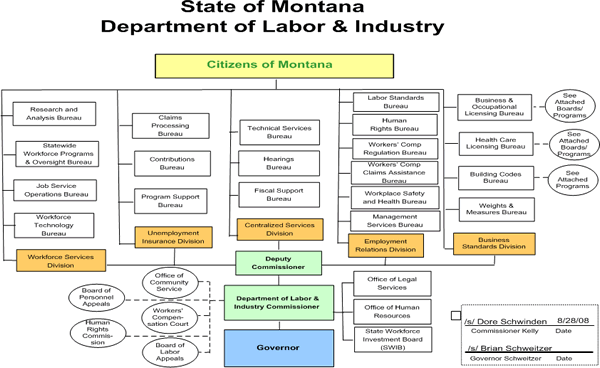
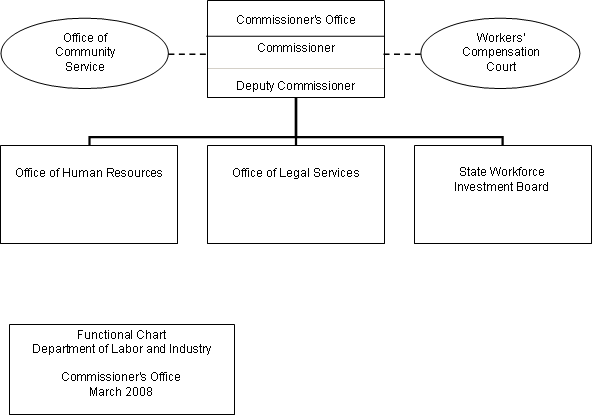
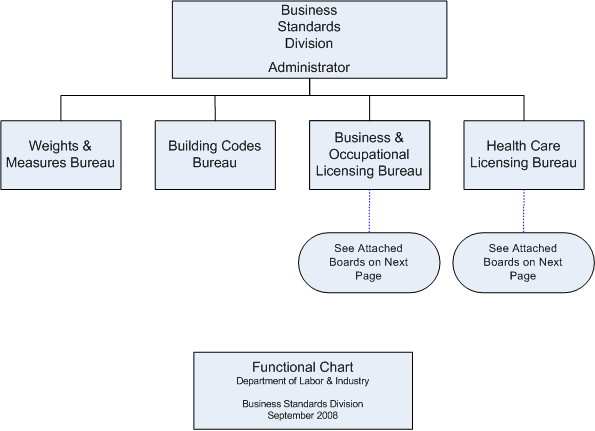
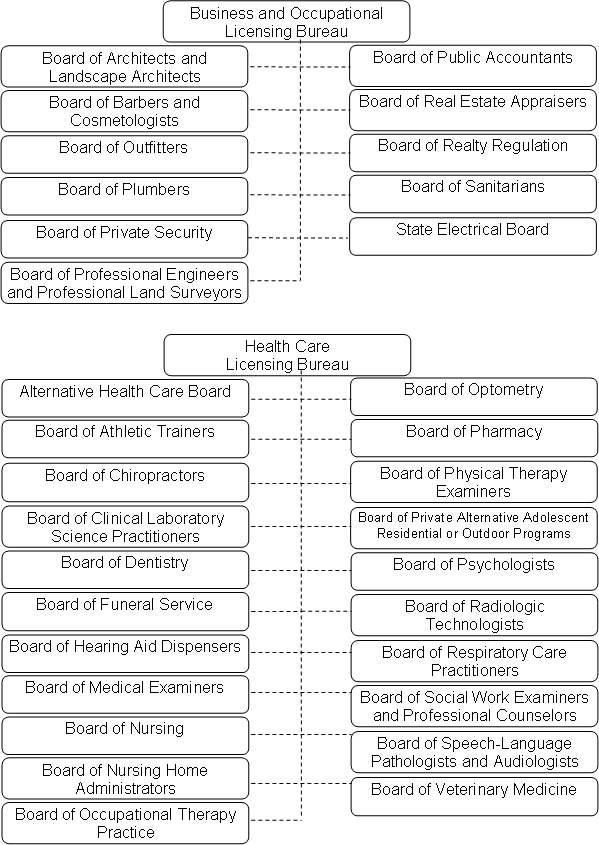 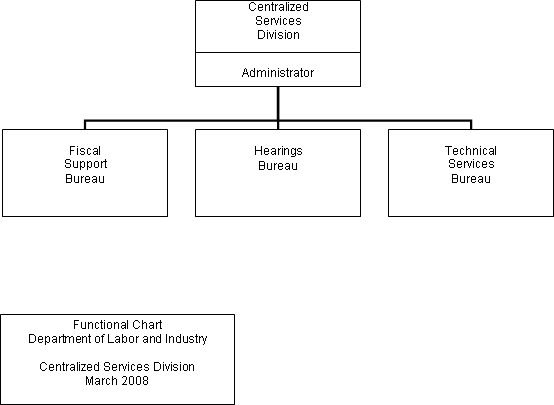 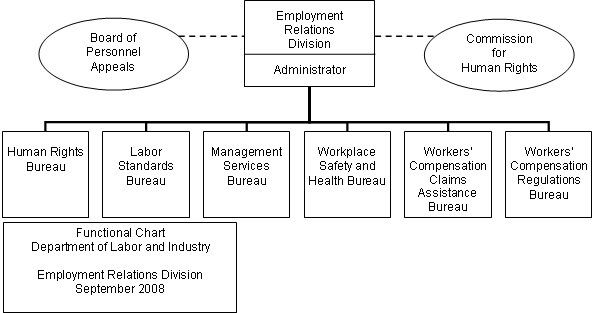 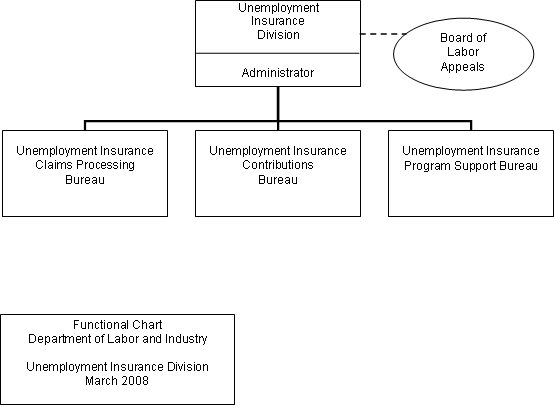
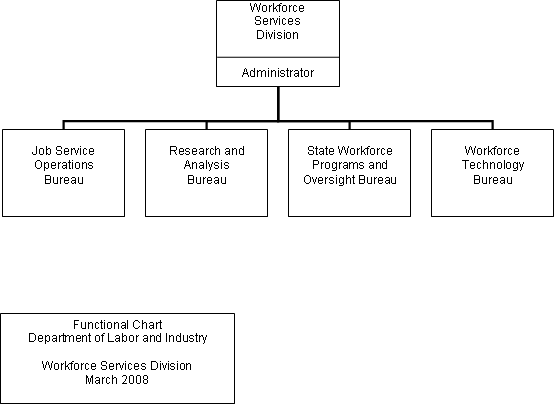
History: 2-4-201, MCA; IMP, 2-4-201, MCA; Eff. 12/31/72; AMD, Eff. 9/5/76; AMD, Eff. 7/6/79; AMD, Eff. 10/1/81; AMD, Eff. 10/28/83; AMD, Eff. 9/30/85; AMD, Eff. 5/30/86; AMD, Eff. 1/1/90; AMD, Eff. 7/1/95; AMD, Eff. 7/1/96; AMD, Eff. 7/1/97; AMD, Eff. 7/1/01; AMD, Eff. 7/31/07; AMD, Eff. 3/31/08; AMD, Eff. 9/30/08. |
A directory of state agencies is available online at http://www.mt.gov/govt/agencylisting.asp.
For questions about the organization of the ARM or this web site, contact sosarm@mt.gov.